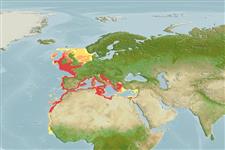>
Eupercaria/misc (Various families in series Eupercaria) >
Cepolidae (Bandfishes) > Cepolinae
Etymology: Cepola: Latin, cepulla = onion.
More on author: Linnaeus.
Environment: milieu / climate zone / depth range / distribution range
Ökologie
seewasser demersal; tiefenbereich 15 - 400 m. Subtropical; 61°N - 10°N, 18°W - 36°E
Eastern Atlantic: British Isles to north of Senegal, including the Mediterranean.
Length at first maturity / Size / Gewicht / Alter
Maturity: Lm 24.2 range ? - ? cm
Max length : 80.0 cm TL Männchen/unbestimmt; (Ref. 27156); common length : 40.0 cm TL Männchen/unbestimmt; (Ref. 26999)
Rückenflossenstacheln (insgesamt): 0; Rückenflossenweichstrahlen (insgesamt): 67-70; Afterflossenweichstrahlen: 60. Body ribbon-like, gradually tapering to a pointed tail. Large, oblique mouth. Teeth widely spaced on both jaws. First two rays of dorsal fin unsegmented. Caudal fin with median rays longer and free at their tip. Dorsal and anal fins more or less joined to the caudal fin.
Found on sand and mud bottom (Ref. 26999). Lives in vertical burrows but may be found swimming in midwater. Occurs singly or in groups. Feeds mainly on small crustaceans and chaetognaths (Ref. 5984).
Eggs are pelagic.
Quéro, J.-C., 1990. Cepolidae. p. 853-854. In J.C. Quero, J.C. Hureau, C. Karrer, A. Post and L. Saldanha (eds.) Check-list of the fishes of the eastern tropical Atlantic (CLOFETA). JNICT, Lisbon; SEI, Paris; and UNESCO, Paris. Vol. 2. (Ref. 5985)
IUCN Rote Liste Status (Ref. 130435)
Bedrohung für Menschen
Harmless
Nutzung durch Menschen
Fischereien: weniger kommerziell
Mehr Information
ReferenzenAquakulturAquakultur ProfilZuchtlinienGenetikElectrophoresesVererbbarkeitKrankheitenVerarbeitungNutrientsMass conversion
Tools
Zusatzinformationen
Download XML
Internet Quellen
Estimates based on models
Preferred temperature (Ref.
123201): 9.8 - 16.5, mean 11.9 °C (based on 326 cells).
Phylogenetic diversity index (Ref.
82804): PD
50 = 0.5312 [Uniqueness, from 0.5 = low to 2.0 = high].
Bayesian length-weight: a=0.00380 (0.00284 - 0.00508), b=2.42 (2.34 - 2.50), in cm total length, based on LWR estimates for this species (Ref.
93245).
Trophic level (Ref.
69278): 3.1 ±0.23 se; based on food items.
Widerstandsfähigkeit (Ref.
120179): mittel, Verdopplung der Population dauert 1,4 - 4,4 Jahre. (K=0.21; tmax=8).
Fishing Vulnerability (Ref.
59153): Moderate to high vulnerability (55 of 100).
Climate Vulnerability (Ref.
125649): Moderate vulnerability (38 of 100).
Nutrients (Ref.
124155): Calcium = 57.7 [33.8, 110.7] mg/100g; Iron = 0.981 [0.583, 1.722] mg/100g; Protein = 18.2 [17.3, 19.1] %; Omega3 = 0.218 [0.131, 0.362] g/100g; Selenium = 47.5 [24.0, 95.1] μg/100g; VitaminA = 12.1 [3.9, 40.0] μg/100g; Zinc = 0.669 [0.462, 0.963] mg/100g (wet weight);
